New video from our friend Eric at polynominal.com featuring the handsome Marcel and a reel-to-reel tape recorder.
this is why you should not let your cat play with a reel to reel tape recorder 🙂
You can see Marcel’s previous posts here.

New video from our friend Eric at polynominal.com featuring the handsome Marcel and a reel-to-reel tape recorder.
this is why you should not let your cat play with a reel to reel tape recorder 🙂
You can see Marcel’s previous posts here.
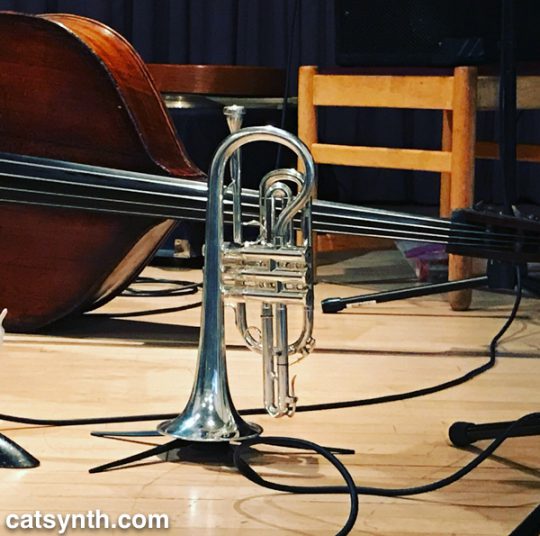
For the final night of the Outsound New Music Summit, we invited two jazz legends to collaborate with noted local musicians. Each of them has performed and recorded with a whos-who of jazz in the late 20th and early 21st centuries. Sometimes such collaborations can go awry in practice, but we at CatSynth are happy to say that both were a resounding success.
Bobby Bradford has had a long career as cornet player and composer who enjoyed long collaborations with the likes of Ornette Coleman and John Carter. He has taught multiple generations of musicians, including Bill Noertker, who invited Bradford to lead a project for this year’s summit. The cornetist and bassist teamed up with cornetist Theo Padouvas and bassist Scott Walton to form Bobby Bradford’s Brass’n’Bass.
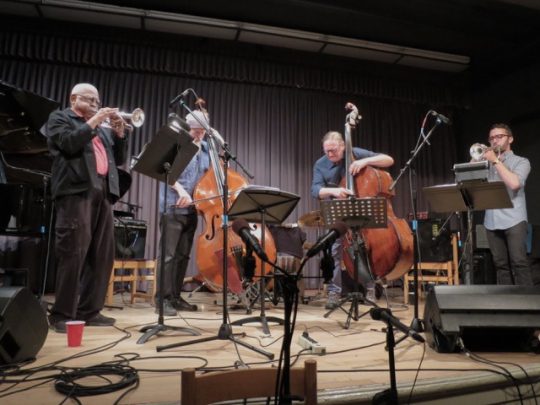
[Photo by Michael Zelner]
The performance focused on Bradford’s compositions, but as in any good jazz setting, each of the musicians brought their own creativity to the set. The instrumentation makes for a sparse texture, with each member of the group having to perform multiple duties on melody, harmony, and rhythm. But the result is an unusual sound. Bradford’s cornet led the way, with Padouvas filling in some of the space with fast runs and other sounds. Noertker and Walton took turns on the rhythm at times but also worked together as a unit. They also doubled as additional melodic instruments in the group. One memorable moment featured Noertker playing long bowed harmonics atop Walton’s back-and-forth plucked bass notes. There was a ballad with Bradford and Padouvas playing nearly the same line what seemed like a different scale and harmony to the basses, resulting in a very haunting effect. Another faster tune was reminiscent of Ornette Coleman in the 1960s (i.e., before the Prime Time era).
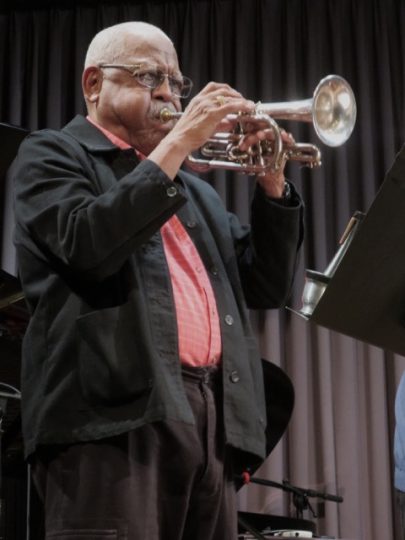
[Photo by Michael Zelner]
As Bradford is perhaps best known as a sideman and a teacher, it was great to see him lead the band with his own music on this occasion. The group did end with a more open improvisation, which Bradford himself admitted he wasn’t sure how it was going to turn out. It was short and sweet, with the musicians bouncing off one another but not overstaying their moments. Overall, I thought this group had a fine debut, and it will be interesting to see if they play together again, perhaps in Bradford’s home turf of Southern California.
The second set brought together pianist Marilyn Crispell with Kevin Robinson’s KREation Ensemble that also included Lee Hodel on bass and Tony Gennaro on percussion.
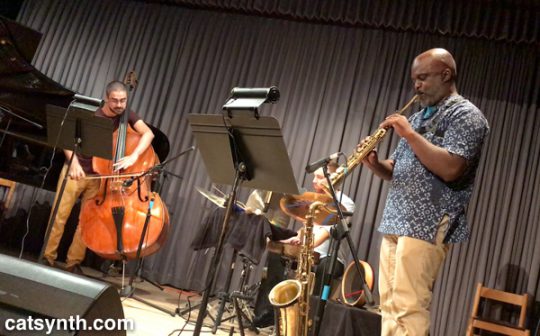
On the surface, this coming together would seem to be a more traditional jazz quartet, but Gennaro had an unusual percussion kit with a variety of hand drums, bells, and more. Indeed, there were times it seemed all four musicians were playing melody lines. And there was a lot of open space, with Robinson’s meditative poses acting as a fifth instrument.
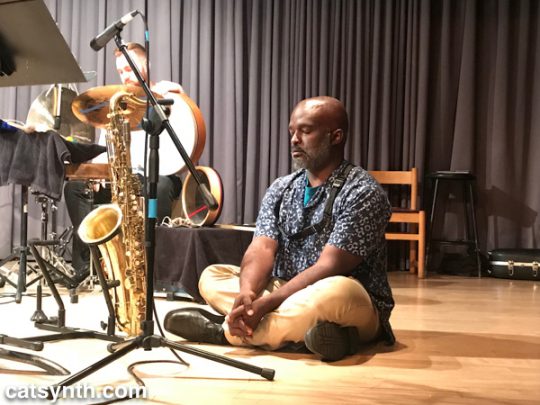
Robinson has a very sparse, detailed and contemplative style of playing, even when he was playing faster sections. This contrasted with Crispell’s frenetic runs on the piano. Hodel was able to match her with percussive notes on the bass. I really liked the way the two of them interplayed. I found myself re-focusing throughout on Crispell to see what she would do next. There was something clever, even mischievous, about her playing, even when it was darker long chords.

The ever-changing style and energy throughout the set make sense in the context of the work being premiered. As stated in the program, “Through the Twisting Prisms is a collection of intervallic, rhythmic, harmonic labyrinths and mazes that explore ideas convergence, expansion, contraction, and meditation.”
Together, the two sets made a fine conclusion to this year’s Outsound Summit. And we had a full house at the Community Music Center, even in the balcony. We finish exhausted but satisfied at a job well done and a great week of music brought to life.
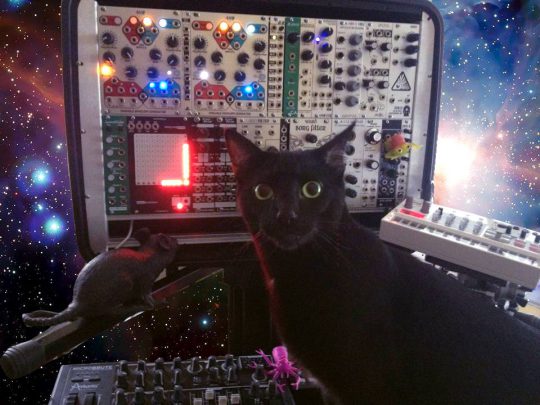
Happy Birthday to our synth-cat friend Runkl in Portland! From Jeph Nor:
HAPPY BIRTHDAY TO RUNKL!!! Our best little goofy cuddle ninja
Jeph hosts the Volt Divers series that I played at in April. If you are in Portland, I recommend checking it out.

Our friends at Ok Housecat are at it again!
This is awesome you’re going to hate it
🆗
🏠
🐈vids tomorrow
And here is the promised video.
Both the photo and video came to us via Ok Housecat’s Facebook page. Follow them for more DIY and circuit-bending fun.
While I thoroughly enjoyed every night of this year’s Outsound New Music Summit, last Friday was special because I was on stage with my own band CDP. We shared the bill with Dire Wolves for a night of contrasting retro styles within the context of new and experimental music.
I often get asked what “CDP” stands for. And while it does stand on its own as a name, it does come from the initials of the original three members: Chaudhary, Djll, Pino. That’s me on keyboard and vocoder, Tom Djll (synthesizers), and Mark Pino (drums). Joshua Marshall joined the band in 2017, bringing his technical chops and versatility on tenor and soprano saxophone. As a road-and-map geek, it also stands for “Census Designated Place”.
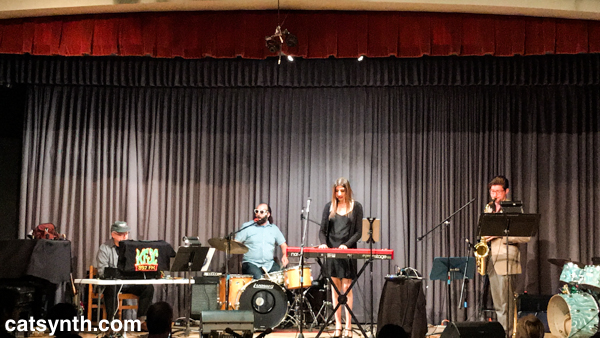
We had five tunes for this concert. Three of them were from the series I call “the jingles”, including White Wine, North Berkeley BART, and our newest song, Rambutan (it’s a fruit from Southeast Asia). Marlon Brando and Konflict Mensch rounded out the set. Each featured a melodic and harmonic head followed by open improvisation – no fixed solos, even listens to one another and comes in and out. Our style is a blend of funk, fusion and experimental music reminiscent of Herbie Hancock’s Mwandishi and Head Hunters bands or Soft Machine 5 & 6, with a bit of 1970s Frank Zappa / George Duke mixed in. The music is a joy to play and I’m so glad to be able to be on a stage playing it.
 We got off to a somewhat shaky start with White Wine, but we settled down quickly as we headed into the improvisation section. From that point on, things only got better with Marlon Brando and North Berkeley BART (which is always a local crowd pleaser). Rambutan was a lot of fun, including the funky 7/4 jam and the call-and-response chant with the audience. Mark held up the metric foundation, working with both me and Tom who took turns on the bass roll. Tom also got some great sounds in his solos, as did Josh who moved easily between growls and mellifluous melodic runs.
We got off to a somewhat shaky start with White Wine, but we settled down quickly as we headed into the improvisation section. From that point on, things only got better with Marlon Brando and North Berkeley BART (which is always a local crowd pleaser). Rambutan was a lot of fun, including the funky 7/4 jam and the call-and-response chant with the audience. Mark held up the metric foundation, working with both me and Tom who took turns on the bass roll. Tom also got some great sounds in his solos, as did Josh who moved easily between growls and mellifluous melodic runs.
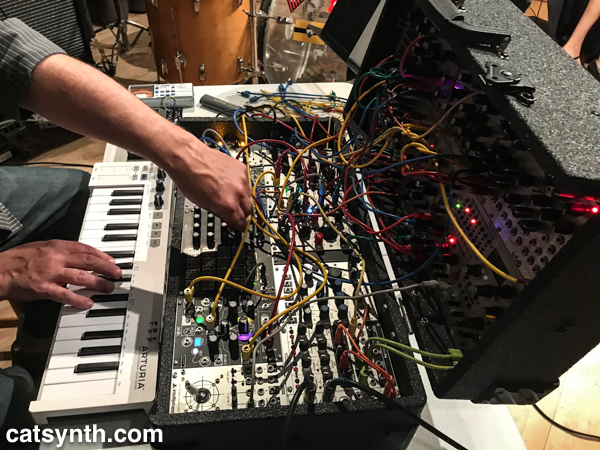
The vocoder, a Roland VP-03, held up pretty well – in some ways, I felt the scatting went even better than the lyrics – though there is still work to do keeping the voice intelligible in the context of the full band. I was exhausted and satisfied after the set, and look forward to doing more with our band.
You can read Mark Pino’s perspective on the set on his blog.
For the second set, Dire Wolves brought a completely different energy to the stage. Where CDP was exuberant and even frenetic at times, Dire Wolves welcomed the audience with a mellow and inviting psychedelic sound.
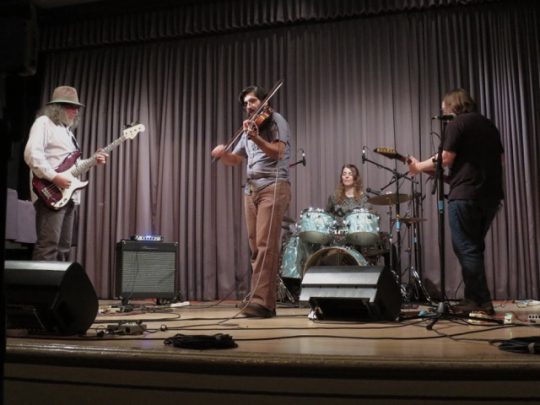
[Photo by Michael Zelner]
There was a sparseness to the music, with Jeffrey Alexander (guitar + winds), Sheila Bosco (drums), Brian Lucas (bass) and Arjun Mendiratta (violin) each staking claim to a distinct orchestral space within the soundscape. Alexander and Mendiratta had lines that melted seamlessly from one to the next; Brian Lucas’ bass was sometimes melodic. Bosco’s drums provided a solid foundation, but she also contributed voice and other sounds to the mix.

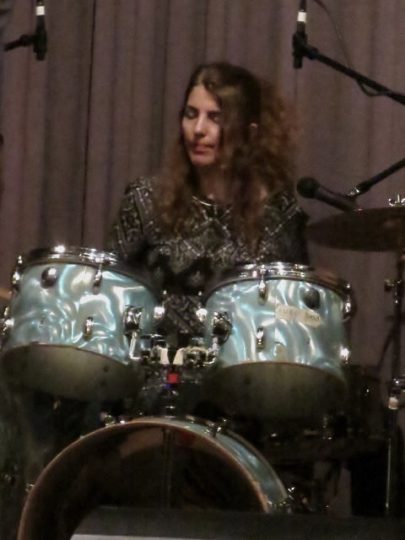
[Photos by Michael Zelner]
My mind was still processing the set we had just played, but the trance-like qualities of Dire Wolves provided a space for a soft landing and to return to a bit of balance. Sadly, it seems this was the band’s last performance for a while, at least with the current lineup. But I look forward to hearing more from each of these musicians in their other projects.
Both groups played to a decently sized and very appreciative audience – not the capacity crowds of the previous or following nights, but respectable. And I got quite a bit of positive feedback from audience members after our set. We still have one more night of the summit to cover, and then it’s onward to future events.
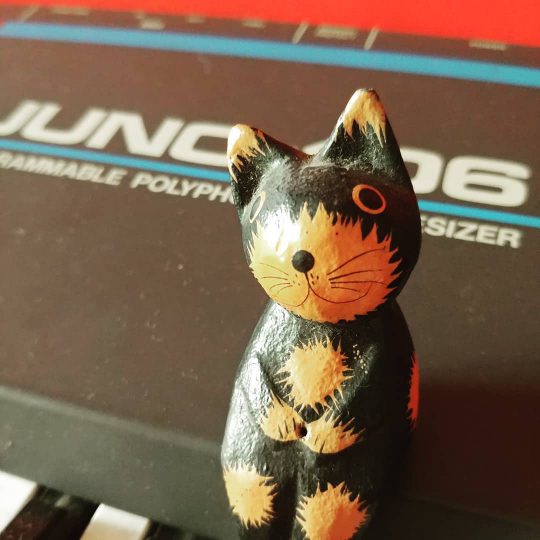
Our wooden feline friend is back, this time on a vintage Roland Juno 106 synthesizer. Submitted by thedigitalpurrgatory (Anton Largoza-Maza) via Instagram. You can see a previous appearance here.
This is the second appearance of the Juno series in less than a week. Last Thursday we featured the Juno 60. The Juno 106 has a full MIDI implementation, including SysEx based editing and control, as opposed to the 60 which has no MIDI at all. Sound-wise they are quite similar, although many say that the 60 has a “warmer sound.” We at CatSynth cannot verify this.